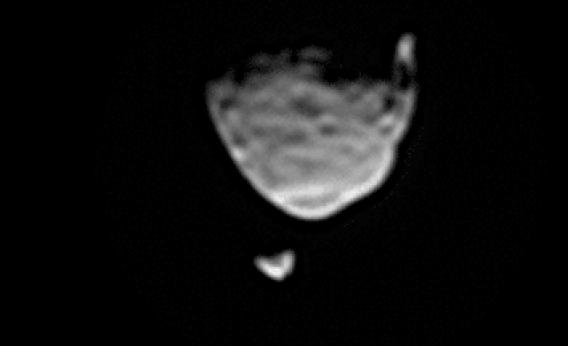Create a free profile to get unlimited access to exclusive videos, sweepstakes, and more!
Martians Moons Jockey for Position

Mars has two moons, named Phobos and Deimos. Phobos is a lumpy potato about 27 kilometers (17 miles) long, and Deimos is more of a charcoal briquette 12.6 kilometers (8 miles) across.
Both orbit Mars very close to directly above its equator, so, as seen from the surface, Phobos (which is closer to Mars) will sometimes pass directly in front of Deimos. This is called a mutual event (a kind of eclipse), and if you happen to have a nuclear-powered laser-eyed mobile chemistry lab on the surface you can point the camera upward and actually capture images that can be strung together in an animation.
Like this, say:
How cool is that? I could go into great detail about these observations by the Curiosity rover, but my friend Emily Lakdawalla has done all the work for me. Go over and read her blog, which has all the fun bits.
It would be pretty cool to have two moons, especially ones as weird as Mars’. Phobos orbits so closely to the surface that it goes around Mars faster than the planet rotates, so it rises in the west and sets in the east (much like the International Space Station does over Earth). Deimos is near the distance where it goes around Mars once per day (the geosynchronous point), so it moves around the sky very slowly, taking over 2.5 days to rise and set!
Like I said: weird. Don’t get me wrong; I’m pretty happy with what we have. Our Moon is great. But there is something romantic and wistful about the idea of two moons gracing a pink and red sunset sky …
Correction, May 26, 2014: I originally wrote that Deimos moves against the stars very slowly, but that's not quite right. Mars rotates at about the same rate the Earth does, though a little slower (once every 24 hours and 30 minutes or so). The stars therefore rise and set pretty much like they do on Earth, but from the surface of Mars, Deimos would appear to rise and set much more slowly due to its orbital motion nearly matching the rotation of Mars. In other words, it moves slowly relative to its position in the sky, not the stars. Sorry about the confusion.


























